It was the last day of archery season and hunting opportunities had been scarce, so I was itching to put a doe or small buck in the freezer. Around an hour before sunset, I tucked into the weedy edge of a narrow field and parked my butt on a milk crate. Across the field at 42 yards, a lone fruit-laden apple tree served as an irresistible magnet for deer. Although I was equipped with a crossbow, the range still seemed like a stretch, so earlier that afternoon, I’d simulated the shot on a 3-D deer target.
by Steve Markwith, contributing writer and author of Survival Guns
Shortly after sunset, a nice doe materialized under the tree and turned broadside to my milkweed hide. With only minimal movement I was able to shoulder the bow and place the scope’s 40-yard reticle line just a tad high behind her shoulder. The bolt discharged with a bang and its illuminated nock streaked through the scope like a brilliant orange tracer before plunging into the deer. Hit hard, it turned and fled through a stand of softwoods as I listened for a telltale crash. With none forthcoming I sat tight.
Finally, in fading light, I tiptoed to the apple tree in search of clues. Immediately obvious was the bolt’s bright glowing nock protruding from a carpet of leaves. It was covered in blood from stem to stern, so I stood it upright to serve as a beacon and commenced the age-old archery ritual of searching for a blood trail. I’ve played this game for decades. Experience dictates a successful outcome is never guaranteed, but in this case, the track was short. Within 40 yards I came upon a stone-dead deer hit right on the money with an impressive exit hole.
Riding the Crossbow Wave
Crossbows have definitely gone mainstream during the last few years. With deer herds on the rise in many states, game management folks have embraced new methods to control the explosion. In more settled areas, archery hunts have helped, but participation hasn’t always been sufficient. Thus, many states (like mine) have legalized the use of crossbows to recruit more archers. Some still eye horizontal bows with suspicion but, for others, they’re simply a mystery begging for a clearer view.
How Far Can You Shoot a Crossbow?
Based on recent advertising involving ranges out to 100 yards, a 40-yard shot should be a no-brainer. Maybe, but the devil is in the details. At a chronographed launch velocity of 342 feet per second (fps), my bow isn’t the fastest by today’s standards, but it’s still pretty zippy. Then again, so are many of today’s vertical compound bows with advertised arrow speeds approaching this velocity.
One thing they all have in common is a marked parabolic arrow flight which introduces concerns about deflections from any overhead branches. On a positive note though, many archery hunters (including me) hunt thicker woods that offer more security for deer. Because these conditions limit visibility, regardless of the bow type, even a thirty-yard shot can be quite the poke.
Of course, some regions, particularly out west, present frequent opportunities well beyond 40 yards. However, extra distances introduce concerns over wind drift and animal movement during the arrow’s (bolt’s) longer flight-time. And, contrary to a popular misconception, most crossbows aren’t dead quiet. Some have quite a snap, enough to alarm many game animals, creating further risks of movement.
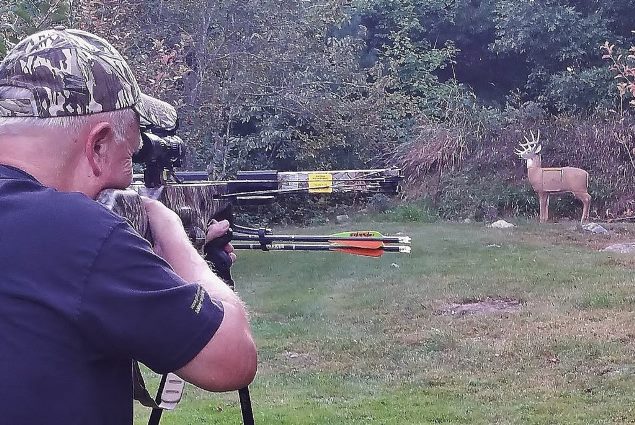
How Accurate is a Crossbow?
Some of the latest high-velocity types are pitched by shooting accurate groups at 100 yards – doable in ideal conditions with a properly calibrated scope. However, even the accuracy of many lower-end crossbows is more than adequate to meet most needs. Like many other crossbow owners, I only shoot one bolt at a time just to avoid smashing up expensive bolts – the likely outcome even at 40 yards where 2” groups are the norm!
A crossbow scope is a worthy investment and many of today’s models now come with one. Typically, it’ll incorporate hold-over lines below the crosshairs, graduated in ten-yard increments for use out to 50 yards. The idea is to zero the scope at 20 yards and use the lower hash marks to compensate for drop.
These systems work fairly well as long as the bolt’s velocity corresponds with the spacings of the lines (or dots). But some of the package-bow scopes are fairly rudimentary fixed-power types of 3 or 4X. I swapped mine out for better Excalibur Tact-Zone variable with a useful illuminated reticle. Instead of magnifications, the power ring is graduated in feet per second. I set it to the 340 fps mark, zeroed the bow at 20 yards, and saw spot-on impacts right out to 50 yards. That’s further than I’d care to shoot at for hunting purposes but, just for fun, I have stretched the range out to 70 yards via the lower tip of the duplex reticle and some hold-over guesstimation.
Manageable Crossbow Systems
Unlike more open western regions, the greater crossbow advantage in my heavily-forested area is a shortened learning curve. Most accomplished conventional archers I know have logged at least several years, during which numerous hard knocks served to refine their equipment and skills. By comparison, a “bow-gun” should be a piece of cake, right? Well, crossbows aren’t rocket science, but there is more going on here than meets the eye.
Power Strokes and Poundage: For starters, to maintain a manageable size, adult-rated crossbows use much shorter power strokes than their vertical cousins. Greater poundage is thus required to offset this difference (power stroke explained).
I shoot a compound bow with 28-inch draw length, set at a peak draw weight of 65 lbs. But, my standby crossbow has a 13-inch power stroke requiring 175-pounds of cocking force. Both use compound-wheel technologies that significantly reduce this effort through pulleys and rigging. Some simpler recurved limb designs (like those from Excalibur) just go with higher poundage – often, much more! However, this simplicity does permit a user to change its basic bow-string without the need for equipment – required to replace a compound’s cable system.
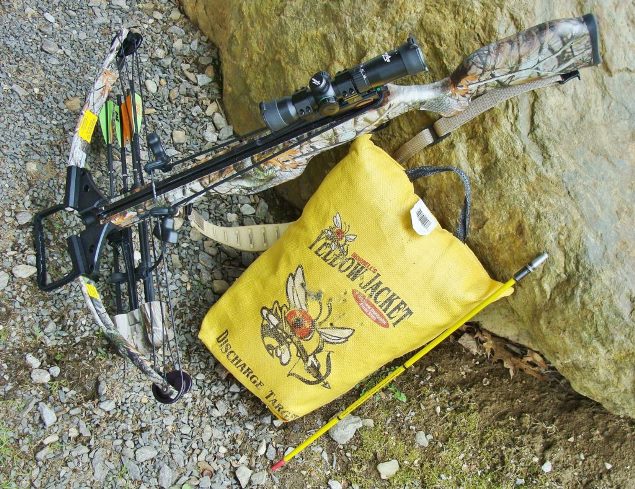
Cocking: Regardless of the design, don’t plan on cocking by hand! It’s possible in some instances, but the string will probably become misaligned, resulting in poor accuracy – at best! If the string escapes during the process, the violent release of energy could result in a blown-up bow with serious personal injuries. For this reason, either a simple weight-reducing rope-cocking system is used, or some type of mechanical hand-crank.
I use a rope cocker, but being of stumpy stature, it can be somewhat difficult to attach depending on the power-stroke. My 13-inch bow translates to a bit of a reach, whereas the same rope & pulley system is easier to hook up to an 11 ½” model. Also, less back-stretching is required to cock it.
Afterward, I just coil the rope system in a pocket. Those physically challenged should shop for hand-crank capabilities. Some brands offer them as slip-on accessories, or as mounted versions. The extremely potent 400 fps higher-end types like the ultra-compact Ravins require one. It’s incorporated as an integral feature and although more complicated, once mastered, cocking is amazingly easy.
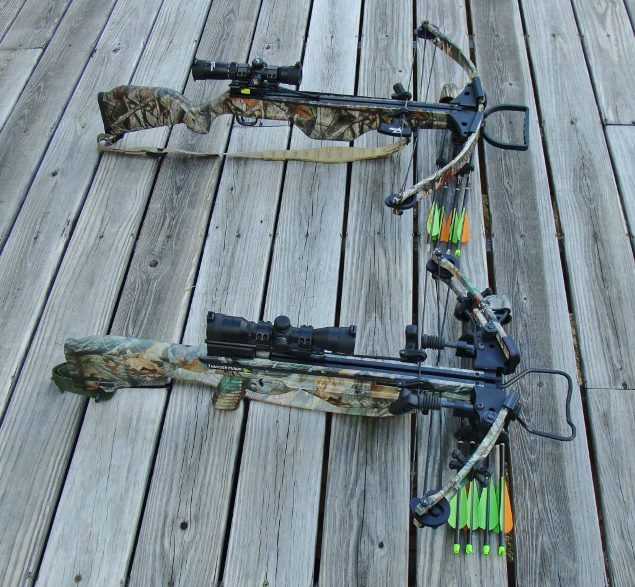
Decocking: Exploding crossbows can be thrilling, so many have anti dry fire features designed to prevent their discharge if a bolt isn’t properly inserted. That’s a good thing, but it can also preclude de-cocking (improvised efforts are dangerous).
Supposedly, some re-curves can be un-cocked through reversal of the authorized cocking process, but I’ll pass. Instead, I use the standard method which calls for shooting – into something. I used a small portable discharge bag designed specifically for this purpose with a field-point.
Lately though, I’ve switched to a heavy-duty fiberglass decocking bolt with a fat flanged head that limits penetration in soft earth. Amazingly, it’s still working well after several season. The trick is to have a de-cocking means on hand once a hunt has ended. Ravin’s crank system is slick because controlled uncocking is possible. For a full understanding of these systems, hands-on examinations are worth the time.
Crossbow Purchasing Advice
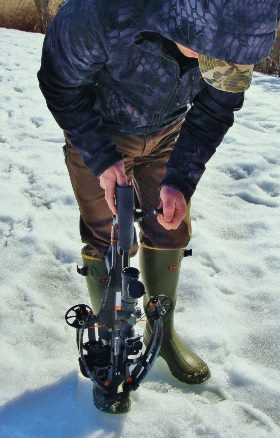
The larger outdoor emporiums now list dazzling assortments of crossbows and accessories but, in light of the above issues, the safer bet could be a true crossbow dealer who will likely have at least several types to play with, often with an actual range.
Guaranteed, you’ll be cautioned to keep your support hand’s fingers clear of the string and cables. Expect a gruesome story involving someone who didn’t, resulting in missing digits. That’s why manufacturers attach warning labels and incorporate features to prevent such injuries. One good advantage of patronizing a local dealer is the direct gateway into servicing or warranty repairs. You’ll also be provided with the correct maintenance essentials like serving (string) wax and rail lube.
Crossbow System Costs
Today, you can easily blow $2,000 for a premium, high-performance crossbow. But, of course, there are others for much less. Assuming the brand is indeed a reputable one, it really boils down to cost versus anticipated use. However, you can still run into SNAFUs.
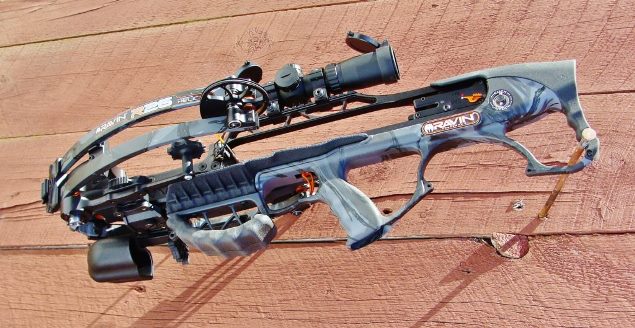
Nearly ten years ago, I bought a 175-lb Parker Terminator which, at the time, was a good pick with a lifetime warranty. I’ve maintained it regularly and problems have been nil, but I finally sprung for a less expensive ($500) spare 160-lb Parker Thunder Hawk capable of using the same 20” carbon-fiber bolts. Luckily, I accumulated some extra goodies (including bolts) because Parker permanently folded their tent last year.
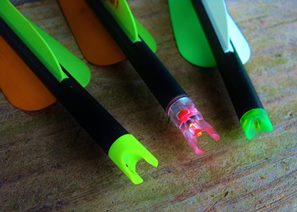
No doubt, they were a casualty of an increasingly crowded crossbow market, populated by brands with larger advertising budgets. In any case, I just saw a Parker listed as a “closeout deal” by a big-name retailer. So, shop carefully and plan on spending some money. Budget bows (and even some pricier types) can be short-lived due to the tremendous energy dump which resonates through every part including their highly-stressed limbs. I’d carefully peruse reviews and maybe start at around $600, enough to purchase some package bows that include a scope, a few bolts, and a quiver. But, you’ll still need some extras…
Extras: Bolts, Nocks and Broadheads
Today, most bolts are carbon-fiber types which must be rated for the bow by length, stiffness (spline), and weight! Several nock designs are also used including flats, moons, and full-capture types (an improper match can result in a wild shot and dry-fire effect). The tip is also part of the equation.
Many of today’s broadheads are designed to fly like target field-points, but they must be crossbow rated; especially the mechanical types that launch with folded blades. For hunting, I add LED illuminated nocks that turn on when kicked by the string. Add these components up and you’ll have a very pricey projectile worthy of careful shooting!
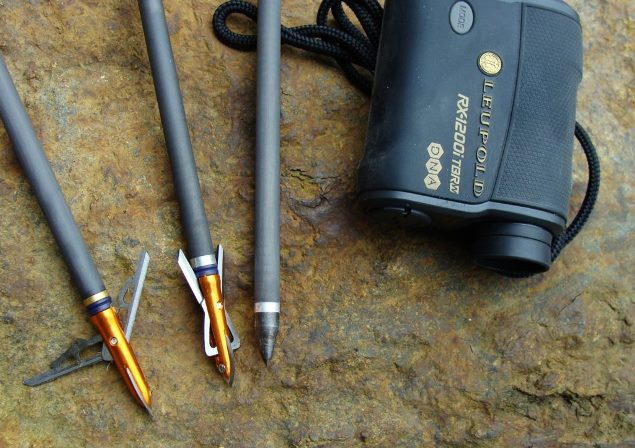
Crossbow Accessories
Follow the manufacturer’s recommendations regarding rail lube and string wax, both of which can greatly improve a string’s life. String silencers are also worth a looks since they can deaden the sound of a discharge. A sling is handy in the woods, assuming the bow can take one (check first). You may also want a carrying case since crossbows are odd-shaped for vehicles. Also, make sure the scope has weatherproof lens covers.
Crossbow-Rated Target: You won’t stop bolts without one and, even at that, high velocity bolts can be brutal to remove! I can use my 3-D deer target, but I shoot at 30 yards or more and wipe the bolt with a very light coating of silicone oil in between. They can be purchased online.
Rangefinder: You’ll need one, not only to utilize a reticle’s features, but also for ethical shots. I use the Leupold RX-1200i pictured above.
Crossbow Concerns
What follows are a few of the hazards unique to crossbows…
- Keep your fingers clear of the string area whenever the crossbow is cocked!
- Watch out for dry fires.
- Don’t use a bolt or nock not rated for the bow.
- Check nocks and bolts for any damage.
- Broadheads are razor sharp and can easily slice flesh, meaning they can also sever a string to cause the same effect as a dry fire.
- Take care to prevent limb impacts with trees, etc. during discharge.
- Rope-cocking a crossbow from a tree-stand is an invitation to disaster. But, so is climbing one with a loaded bolt!
- Don’t drape a cocking rope around your neck where it could become entangled with the bow!
- Handle a crossbow as you would a rifle and respect its business end.
- Un-cock as soon as possible after a hunt.
Store the bow un-cocked, in a cool dry place. These steps, with proper lubrication, have kept mine going for years. Also, check for any local restrictions and laws regarding crossbow hunting. Some states require special crossbow training prior to their use afield which, in light of the above, is actually a good thing.
Final Thoughts
I got into crossbows as a result of a wrecked neck. Because I mostly hunt from the ground, one anticipated benefit was elimination of draw movement. As I soon found out though, timing is still involved. A fully decked-out crossbow can be heavy enough to exclude shouldering until immediately before a shot. Many can also be difficult to carry in the woods. They tend to catch on everything (even when slung) and most balance awkwardly, making hunting on foot impractical (although the new ultra-compact versions are better).
As mentioned earlier, some crossbows can also be noisy when discharged. Hunting from separate stands one quiet evening, my son clearly heard mine let loose from 250 yards. Concerning nearby house dwellers though, noise should be a non-issue. And with the proper crossbow setup, any decent rifle shot should have no trouble achieving fine accuracy in short order.
Is a Crossbow Right for You?
I enjoy shooting mine, but it sees little use beyond our month-long archery season. Still, many aging bowhunters have gladly made the switch as the result of physical issues that create vertical-bow challenges. A crossbow can also provide die-hard hunters with access to real honey holes that are just too tight for firearms. But, for casual use, or for game smaller than turkeys, given the cost of a bolt alone, there may be better alternatives.
